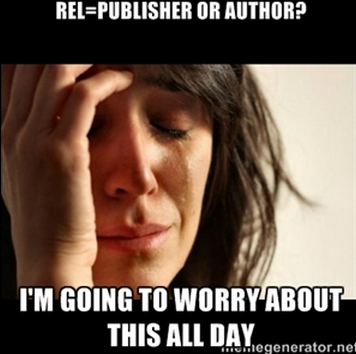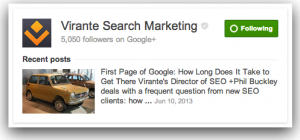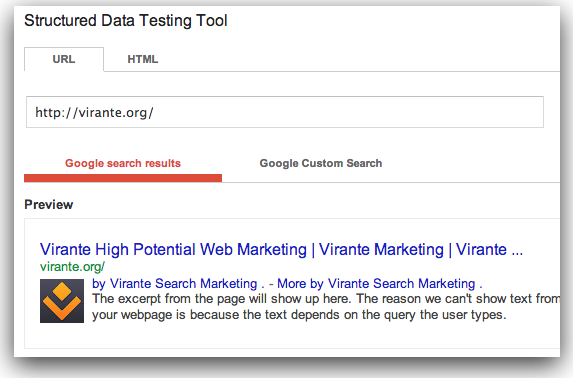 UPDATE: rel=publisher & Google In-Depth Articles
UPDATE: rel=publisher & Google In-Depth Articles
12 August 2013 – Google’s recently introduced In-Depth Articles search feature includes a special role for rel=publisher (verified brand page) connections. If the web site hosting an article featured in the In-Depth results box has a verified Google+ brand page connection, Google will pull the brand’s logo from that page.
This sounds small, but it is the first direct use we’ve seen of the rel=publisher connection, except for Knowledge Panel brand results (see below). And it may be one more confirmation that Google is using brand pages (or soon will be) to ascertain brand authority on topics.
Original Post:
Among the most frequently-asked questions we get at the Google Authorship and Author Rank Community on Google+ are those concerning the usage of rel=authorship and rel=publisher connections.
Or to put it another way, should your site have an Authorship connection to Google+, a Publisher connection, or both? And for what is each intended? To what parts of your site should each be applied?
This post will attempt to “disambiguate” the terms (as they like to say over on Wikipedia) and give you a guide to how to use each properly. Let’s start by defining the two terms:
What Is rel=author (Authorship)?
Google Authorship (rel=author) is a program instituted by Google in 2011 that allows authors (content creators) to establish a verified, two-way connection between their Google+ profiles and their content anywhere on the web. Making this connection (see our post on verifying Google Authorship) provides at least the following possible benefits:
- You qualify to have your Google+ profile photo show next to search results for your content (the Authorship “rich snippet”).
- You will likely get a higher-than-normal click-through rate (CTR) for authorship snippet search results lower than the first result on a search page. See “How Does Google Authorship Affect CTR?” – an excellent study by Justin Briggs.
- Possible protection against being outranked in Google Search by those who scrape your content and republish it on their own sites.
- The (future) possibility of gaining “AuthorRank,” a boost in search results for your content in topics for which you become recognized on the web as an authority.
- You build Google PageRank authority for your profile if you connect your Authorship to your content on high-authority sites.
Here’s how to establish verified Authorship for your web content.
What Is rel=publisher (Google+ Verified Publishers)?

A “knowledge panel” result for a verified brand on Google Search
rel=publisher is a schema.org markup tag that Google has adopted to allow web sites (“publishers”) to create a verified connection between their official web sites and their Google+ brand pages. The immediate benefits of this are a lot less clear than for Authorship, but at present they include:
- Qualifying for a check mark next to your brand page name on Google+, which lets Google+ users know that this is the official, verified page of the associated brand name. This is important as anyone can start a page with your brand name (i.e., there are no unique names on Google+).
- Allowing Google to aggregate your +1’s to amplify your count. If you have a verified connection for your brand page, the +1 count displayed on your brand page will be a combination of followers of that page, +1’s given to the page directly, +1’s on your web site, and the total membership of any Google+ communities owned by your page. In addition, if you connect your AdWords account to your Google+ account, and enable the social extensions in your AdWords campaigns, your +1 count may show up on your AdWords ads.
- The possibility of getting a “knowledge panel” result for branded searches on Google Search. See illustration at right. This doesn’t display until your brand page builds up a certain amount (how much we don’t know) of engagement on Google+. It shows prominently in the right panel of search (replacing ads) and displays your logo, the name of your G+ brand page, the number of followers you have on Google+, a Circle “chicklet” that allows people to add your page to their Google+ circles right from the search page, and your most recent Google+ posts.
In addition, some are speculating that at some point Google may start to display a logo rich snippet in search results for verified brands, similar to the present Authorship result. Beginning a few months ago, Google began displaying an example of such a result in their Structured Data Testing Tool for verified brands. Below is an example. Remember, this is not yet actually showing up in search results.

Structured Data Testing Tool preview
My guess is that if they activate publisher rich snippets, they will be shown for results leading to general pages on your site, such as the home page, about page, etc. I would expect that for any content pages with Authorship markup, an author snippet will supersede the publisher snippet in the SERPs.
In addition, Mike Arnesen of SwellPath has speculated that there may eventually be some sort of “brand rank” for verified brands wherein the verified connection will help boost their search rankings for topics in which the brand is a recognized authority. At SMX Advanced in Seattle this past week, Google’s Matt Cutts spoke about Google “getting better” at identifying the topical categories for which a site ought to rank.
Here’s how to verify your brand page with Google.
When and Where to Use rel=publisher vs rel=author
The most confusion about these two connections seems to be around where each should be applied to a site. Are both useful for an entire site or only on specific content or pages?
Let’s start with the easiest answer.
rel=publisher is for your whole site.
Since rel=publisher is meant to be a verification connection between your official web site and your Google+ brand page, it should be applied to your whole site. Actually, you really just need to make the connection once, preferably from your home page. You can do this by at least four different methods:
- Add a Google+ Badge to your home page. This has the added advantage of making it easier for visitors to visit your page or add it to their circles right from the badge.
- Create your own link from your site to your Google+ brand page (be sure to include a rel=”publisher” tag in the link).
- Hide a link in the header of your site, using the format <link href=”GooglePlusBrandPageURL” rel=”publisher”> (where obviously you substitute your page’s URL for GooglePlusBrandPageURL).
- If your Google Webmaster Tools email address is the same as the Google+ profile address you used to create your brand page, then verification may take place automatically. (See this post by Ann Smarty, with credit to Brian Jensen for the tip.)
Again, it’s important to understand that rel=publisher is a “once for all” connection to be made between your web site and your Google+ brand page. You do not need to do rel=publisher markup on specific pages of your site for it to work for you. And don’t forget to link to your web site from your Google+ page “About” section! That’s necessary to establish the two-way verification for Google.
rel=author (Authorship) is for original content by real people.
Google’s intention for Google Authorships is to help identify and make a connection between real persons who create content and their content across the web. That’s probably the major reason why Google held off on making any big deal about Authorship until after Google+ was unveiled. Google+ makes it easy for people to create self-identifying Google profiles, and to connect those to the places where they post original content (via the “Contributor To” link section in their profiles).
Therefore, ideally a rel=author connection should be made only between original pieces of content clearly authored by someone with a Google+ profile and those author’s Google+ profiles. Alternatively, if you have multiple authors on your site and each one has his or her own author profile on your site, and their content on your site is linked to their site profiles, then you can just create a rel=author link from each of their site profiles to their respective G+ profiles. Make sure they each link back to your site or their site profiles from the “Contributor To” link sections of their Google+ profiles!
Can I Apply Authorship to My Whole Site?
Some webmasters try to apply Google Authorship to every page on their site, even info pages or product pages. They do this because they have heard of the possible benefits from Authorship rich snippet results (see above), including increased traffic. I discourage this practice for two reasons:
- It creates bad user experience. People are getting used to associating authorship rich snippet results with rich content by a real person whom they can trust. Landing on a product or FAQ page probably creates disappointment, and may increase your bounce rate.
- It may actually lower your CTR for some pages. I have heard from ecommerce site webmasters who were pretty certain their organic traffic actually went down if they were able to trick Google into showing an authorship snippet for product page results. This may be because people searching for a product find a face photo disconcerting, or even off-putting. It just doesn’t belong, so they ignore the result.
- Based on the prior two reasons, I believe that if and when Google starts using Authorship as a direct ranking signal for search (the much-talked-about “AuthorRank”), Google will find ways to downgrade or even penalize Authorship used improperly. Google reps have said repeatedly that the intention of Authorship is to help people connect with topically-rich content by recognized real authors.
That being said, is there ever a time when it is okay to connect Authorship to a whole site? Yes, and this was confirmed by Google’s Matt Cutts during an “Ask the SEOs” session at SMX Advanced 2013. Matt said that for personal sites, such as your own blog, where you are the only author, it’s fine to just connect the entire site to Authorship (you could do this by just putting a rel=author G+ profile link in your site’s header). In fact, he does that for his own personal blog. In addition, Google actually offers a simple method for verifying Authorship via your email address.
Conclusion
I hope this helps clear up some of the confusion between rel=author Authorship and rel=publisher verified publisher status with Google. If you have any questions (or a differing opinion!), please let me know in the comments.





Thanks for the post here… I hope our ‘other conversation’ on G+ re. choosing to be a Profile vs. a Page and how that ties in here can inspire another helpful post and perhaps some content for a Hangout on Air Discussion some time soon.
This subject was in my ‘to read about list’ for next week, thanks Mark for saving me la hustle.
Hello,With my targeted keywords in Google i cant view my rich snippet for my subdomain site , http://www.nmcollege.seotogrow.in .
Any suggestions will be appreciated
Thank you so much for the clarification Mark, my site is a single author site and I currently have the publisher and authorship markup in the header but I wasn’t certain if the authorship markup was okay to be there. I’ve scoured the net looking for the answer but no one has simplified it like you have. For someone like me that has zero code experience it can be difficult to understand.
This was so clear and helpful Mark, thank you. I look forward to sharing it with everyone who I am helping to discover this new platform.
Mark,
What is you take on using rel=publisher on multiple domains (or sub-domains) owned by a single brand. There is no way to add multiple links from your brand page (that I know of), so there is no way to establish the 2 way link. It there any value in having the rel=publisher on the other sites anyway? We have clients that have a main website and an external blog that they have been writing to for years. It seems like it would be ideal to have the main site and the external blog associated with the same brand via rel=publisher.
JR, unfortunately this is one of those cases where it’s Google’s way or no way (with little flexibility). They’ve set up rel=publisher to be a one-to-one relationship between a single Google+ brand page and its (one) official domain. So in order to make use of rel=publisher, you would have to create a unique brand page for each of your domains.
It’s the same way for Google+ Local. A business that has multiple locations has to create a Google+ local page for each one.
Yo Mark, thanx for a great article on the authorship VS publisher issue.
When you gonna add a G+ sign in for your comments?
I signed in using FB, but would really prefer to sign in using G+ where I follow you and keep abreast of many other issues.
Enjoy and keep up the great work which helps many more people than you actually believe, coz guys like me refer our clients to your work to back up what we say.
Your comment above on Google Local is also a common question that I get, and having you quote what I say has helped me… (maybe I am quoting you with out even reading your article)
Once again thanx for the work that you guys make public… it helps plenty.
So, if I have have a main site and a blog would I need to have two separate G+ profiles? I’m just trying to markup my blog, but have been getting this error message: This is not a verified publisher markup.
Good discussion about authorship and publisher. if I use both (authorship and publisher) account on sites, then, does they impact on site performance?
Great Article, I agree with your thinking, Google, really needs to clarify things more. I don’t know why they can’t state it as clearly as you just did.
Thanks for helping clear this up a little more. It’s been very confusing because most of the google instruction refer to your google plus page. Many times I’m trying to figure out if they are talking about personal or brand page.
@ Mark,
What would be your opinion about rel=publisher since it is for the whole site? For example, on our site we have directory pages which have rel=publisher, however a directory is not content. Do you think Google would not approve of this? Or is linking any type of page with rel=publisher okay no matter the design of the page, eCommerce, directory pages, etc. Your thoughts are welcome.
Regards,
Greg
Thanks for the post. I really get useful advice here. Now I’m using author for our website, but maybe I need to think more about publisher.. It’s not complicated much, but need to think carefully. Thanks again!
Can I use them both?
Thanks
P.S My site is http://www.unforgettableholiday.com and I am using both. Will that affect me?
Yes, you can and should use both. rel=”author” is for each individual content creator on your site, and rel=”publisher” is to verify to Google the connection between your site and its official brand page on Google+.
Thank you so much for your explanation! Publisher – whole site, author – articles. I think the easiest way is to put a g-plus button on your articles.
An easy way to think of rel=author would be that it belongs to blog posts.
Great article. I have seen some web agencies adding the publisher tag in all their client.s website. I’am curious to have your opinion on this. What are the possible advantages and disadvantages of this practice?
Publisher tags should be thought of as content that isn’t specifically tied to your name unless you wrote it.
Hi Mark,
so reading from your article, it would be sufficient if I put the publisher rel link in my meta tags only instead of all pages ?
I have 3 different language websites, same company.
I have one google profile from which I made 3 company pages.
Where do I link my 3 websites to, in the rel publisher tag: To the pages which would in this case be more appropriate or to the profile page ?
Also, i do have on all my pages on my website that google+ badge fanbox, like the facebook fanbox.
What would you suggest !?
Dietmar,
There has to be a one-to-one relationship between a Google+ Page and its official web site. So you should link each of your sites to its own G+ page with the rel=”publisher” tag. As far as I know, this has to be an actual link (not just a meta tag) even if it’s in the header of the site.
Excellent article! But the company logo is shown for sure whether the procedure is done well? How long does it take?
Thanks, this is by far and away, the most helpful and clear post I’ve found online with regards the differentiation between publisher and author. Thanks 🙂
I have two commercial websites and one Google plus account which has been set up using my name…… I have content that is added that is not written by me… and that I would like the websites to be connected to a commercial G+ Account(s)…
I have set up the G+Account under my name…. and I have linked to that as an author… (which seems to work ok) but with this G+ account it means when I look to add a badge to my website it has my name… as the publisher..
how can I set up a G+ Commercial page/account?
Another georgeous article. Thanks, Mark!
What do you suggest regarding the combined use of author / +1 and publisher / +1? I thing it would be good to offer users easy options for both circles and +1s as well on profils (author) and pages (publisher). Your opinion?
And what do you think about the use of tools like addthis or sharethis to leverage the full potential of publisher, author and +1?
Cheers Jeanette
I came here because I am confused about the ‘author’ tags, and this article went a long way in clearing that up. However, if you have time, could you please answer a question for me?
I run a website that offers free public domain ebooks in different formats. Now clearly I didn’t create the actual content, but I DO format the books myself, adding illustrations, etc. Would it be ok if I used the ‘author’ tag on those pages (the pages also have author info, book info, etc as well as the download links.)
At the moment, I’ve been unsure because although the formatted books are my creation, the content in them, isn’t.
Any help you could give would be most appreciated,
Kind Regards,
Aisha
In all it might be true not to use the author tag in all cases, for example in a productpage of a shop.
But only using it in your special written article is not enought i think.
You have to decide the use in every case new. For example a special Landingpage can be klicked more often – an example: the explanation of a special product is useful with an author tag because it increases the trust of the given information i think.
I have added on Google author tag on 1 my client’s site http://www.abbeytrinitydental.ie/ but in search result its showing post by author name but his image is not displaying. I searched “Dental tuam” Can we use author tag on home page as well?
I verified on testing tool, everything seems to be fine.
Please help why image is not showing up
I’m so confused by all of this. I did the authorship thing and thought I was supposed to apply it to my entire site. I have the code in my header tag as well. Should I switch that then? I wish google was more user friendly. All this back end stuff is very frustrating.
Thanks for this. We were trying to figure out how to add our G+ profile picture beside our website in the search results. But the topic came up of the author or publisher. You’ve explained this perfectly Mark.
Thank you!
I have the same question as Greg – what do you think about having a rel=publisher tag for pages that aren’t really written content per-se… pages like directory listings, statistic pages, etc. What’s the deal with having publisher tags there – good or bad practice?
I share the confusion of others.
For an eCommerce site, I want rel=publisher for the whole site, including product pages.
So according to this, I have the badge on the home page, but NOT in the Header.
That’s fine. But then for the product pages, news items, articles, etc., I want the rel=author, since I write that material myself.
So if I place the rel-author in the Header for those pages, it will conflict with the rel-publisher on the home page.
In other words, I have no way of placing the rel=author on every page except for the product pages or the home page.
Argh!!!
Well, raise my rent. I finally figured this out.
Again this is for an eCommerce store. But what I’ve just realized is that you DON’T want any of this code in the Head.
For rel=publisher, I dropped the badge code on a banner on the home page of the store. In the Structured Data Tool, the Publisher is verified, but there is no Author (which is the way it’s supposed to be).
I also added the rel=publisher on every product page by including it in the third column of my product pages. I’m not entirely sure what I did, but when I look at a product page, it’s there on the right. It looks ugly, but it’s there at least.
Then, on my platform, I have “News” and “Pages” which are unique content, like articles, videos, etc. For those, I used the rel-author badge.
So in no case do I have the code in the Head, which is where a lot of gurus tell you to put it.
Google has come up with Badges (https://developers.google.com/+/web/badge/). Should we use badges instead of rel=publisher.?
Thank you for clearing doubts about author and publisher. Fantastic blog just love it!!!
Having read this very useful article and discussion I still don’t have an answer to the question – if you have a Franchise model (main website which many franchisees are contracted to use) can each of the franchisees link their Google brand page to the central website? If so, how best to do that as clearly you would not use a G+ button as there would be too many (more than one would be confusing)?
This is pure gold… I have only just managed to get my google authorship active on my how to dj site!
In the end, I managed to synch it all and my blog posts now show authorship 🙂
Great read and excellent info!